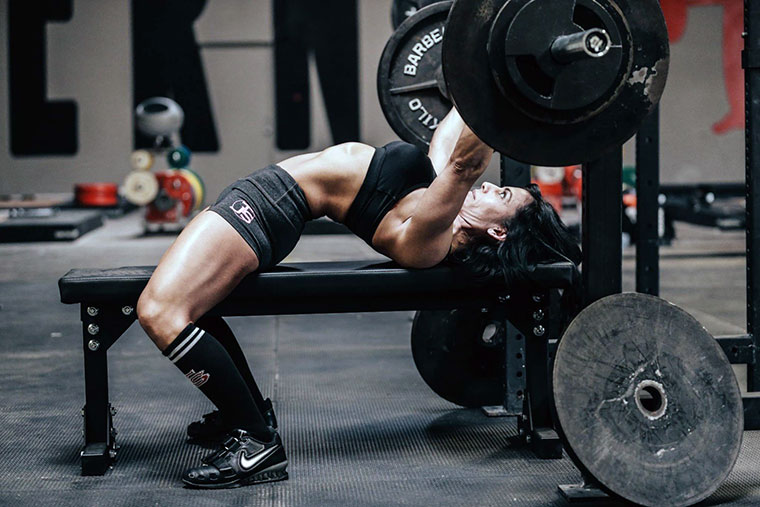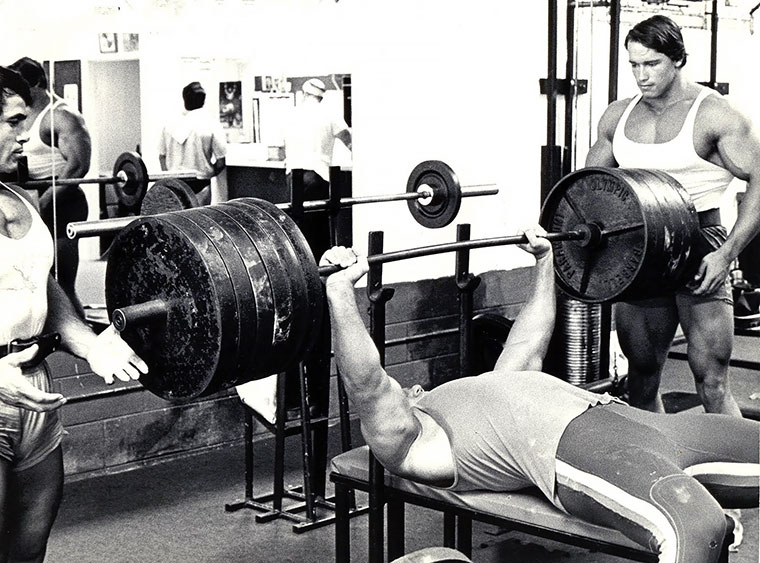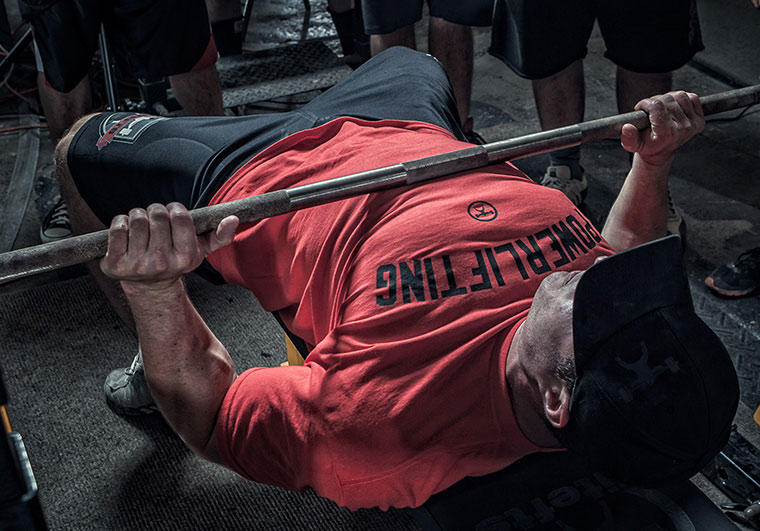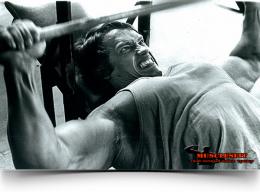SPORT How to shake 150 kg or all about the bench press technique
150 kg is not the limit. It is possible to reach 180-200 kg, but does it make sense? After all, it is important not only to reap a lot, but this is not the goal in most cases. Basically, we press to pump up the pectoral muscles (excluding powerlifting) and there is no direct relationship between the squeezed weight.
I’ll tell you how to properly perform a bench press, while simultaneously progressing in working weights and chest volume.
Bench press is different
There are two main variations of the classic flat bench press:
- bodybuilding;
- powerlifting.
The latter is aimed at the maximum result in one repetition and it does not matter how you achieved it. For example, techniques are used to reduce the amplitude of movement like a "bridge":

Also, in addition to the chest, absolutely all possible assistant muscles are involved to the maximum, starting with the legs, continuing with the back and ending with the triceps with deltas. Compared to the bodybuilding version, the movement is similar, but fundamentally it is completely different.
Of course, with an increase in strength, the volume of the pectoral muscles also grows, but developing them with the help of powerlifting is like hammering pushpins with a sledgehammer. Harmful and meaningless. Unless, for a change, you can sometimes try power penetrations, but no more.
In this material, I will talk specifically about the bodybuilding version of the bench press, increasing strength indicators and effective chest training in general, which will require a number of other exercises.
However, if you want to work in the direction of powerlifting, start with a video Yuri Belkin:
And the nuances of the power bench press from him:
Bench Press Technique Bodybuilding Style
Usually guys come into the gym and just press the bar from the chest. He lowered it to his chest, lifted it - nothing complicated. At first sight.
Working with an empty bar is really easy and not even traumatic. But as soon as you start to increase weight - and beginners like to do it abruptly and thoughtlessly - as problems begin with the hands, shoulders, pectoral muscles are torn, and even lumbago happens.
The second problem of mediocre exercise technique is that people very quickly hit the ceiling, which they then cannot overcome for years. Moreover, the "ceiling" is quite modest - 60-70 kg, rarely more. And this is when training the pectoral muscles several times a week with a dozen exercises.
Do you recognize yourself? Well, you will have to work again with an empty neck in order to set the technique for performing the exercise, and only then proceed to a very smooth increase in weights. We will talk about the training program a little later, but for now we will analyze the technique of performing the exercise directly.

In fact, there are many options, although each differs only in details, and the base is the same. First, let's talk about her darling, and then about the details.
Highlights of proper bodybuilding bench press technique:
- The grip of the bar is closed (the thumb wraps around the neck from below).
- The buttocks are pressed to the bench, the lower back, if possible, too, the legs rest on the floor with the entire foot.
- Grip width - slightly wider than shoulders, so that in the lower position the barbells of the hand are exactly opposite the elbows, and not to the left or right of them.
- The bar lies on the base of the palm, keep the brush straight and in no case bend it back - this is fraught with injuries.
- The bar is lowered to the level of the nipples or slightly below them, so that, again, the hands are opposite the elbows and do not move forward or backward in relation to them.
- The amplitude of movement along the arc, that is, the bar falls to the level of the nipples or slightly lower, and rises to the level of the eyes, and not strictly up (in the latter case, the triceps are strongly involved in the work, stealing the load from the chest).
- At the top point, do not fully unbend the arms (do not insert the elbows), maintaining tension in the chest. At the bottom point, do not throw the barbell on the chest and also do not relax the muscles, but only lightly touch the chest. We work within the amplitude.
- In no case do not drop the barbell on the chest. We lower it under control and smoothly: 2 seconds for a negative movement (lowering) and in the process we inhale air, 1 second for lifting (positive movement) and exhaling.
The bench press was shown clearly and quite well in his video Denis Borisov, albeit with its own characteristics:
In particular, I do not advise you to throw your legs on the bench at first - this is quite dangerous. Too precarious. Although the load on the pectoral muscles increases, plus this is a good option if you feel discomfort in the lower back. When it happened to me, for a couple of weeks I could press from the chest only with my feet on the bench.
In addition, Denis suggests not to reduce the shoulder blades, but instead fill the chest with air as much as possible. Try this way and that, but I personally find it more convenient to reduce the shoulder blades, which noticeably takes the load off the front deltas and makes you more stable during the press, as the back becomes flat. This was very well said (and shown) Bradley Martin:
Also pay attention to the position of the hands relative to the body. Bradley showed lifter and builder options. I'm comfortable with something in between, you try this way and that. We are all different - the attachment of the ligaments, the structure of the muscles is different, so someone will be more comfortable with one thing, someone else. In any case, at the bottom of the amplitude, the arms should not diverge strictly to the sides, since this is not a completely natural and working position for the chest during the press.
How to pump chest and increase the working weight in the bench press

I'll start with the working weight, if the number of plates on the bar is still a priority for you. In addition, increasing the working weights also increases muscle mass. The easiest option is to read a book Stuart McRoberta « Bench press 180 kg". There are several simple programs that really work, allow you to get out of a state of deep stagnation (plateau) and significantly increase the result in the bench press. At the same time, in other basic movements, grow strength.
What helped me personally significantly increase the working weight in the bench press, as well as noticeably grow the pectoral muscles. In fact, a whole range of exercises and specialization. But I'll tell you about everything in order.
A year and a half or two years ago, my bench press “floated” in the region of 100-110 kg, although more often the working weight for 10-12 repetitions in several approaches did not exceed 90 kg. Now I'm benching 130 for 6-8 reps, and my 1 rep max is in the range of 150-155 kg, although it could obviously be more if I focus on powerlifting technique. At the same time, my own weight is 102-104 kg.
The first notable shift was when I started training the chest more than once a week, plus added such an exercise as push-ups from the bars with weights. About 10 years ago, I tore my chest while doing it and have not done it since then, returning it only last year.
In particular, for a couple of months I did three times a week, in which I alternated bench presses and chest push-ups from the bars, gradually increasing the weight. By the way, Denis Borisov showed the technique of chest push-ups well, but I also recommend that you extend your arms less at the elbows (up to 90 °) so as not to load the triceps, due to fatigue of which you can simply not load the pectorals:
As for the smooth increase in load, I talked in detail about how to do this in.
In addition, work on the assistant muscles gave me a clear progress in the bench press. In particular, on deltas (military bench press, barbell row to the chin) and triceps (narrow grip bench press, French bench press). At that time, the working weight in the bench press increased to 115-120 kg by 6-10 times.
Then I tried to specialize directly in the chest, as well as in the back and deltas. The point was that every muscle in which he specialized, he trained twice a week. In the case of the chest, one workout was strength (up to reaching the one-rep maximum), the second was high-volume for 15 repetitions. Plus, a special selection of exercises (bench press, bench press in the hammer on the upper beam of the chest, push-ups from the uneven bars, breeding in the "butterfly" or crossover) and a smooth increase in working weight from workout to workout. Details about this, including a training program, are written in the following article:
As a result, I reached the current indicators in the bench press.
Important nuances

Finally, I will raise a few points regarding chest training that will help you progress.
In particular, the bench press on a horizontal bench is not suitable for everyone directly to increase the volume of the pectoral muscles, that is, for their hypertrophy. For example, for some people, deltas and triceps work more in this movement. Bench press on an incline bench at an angle of 30-45 ° is considered more effective. I personally prefer the dumbbell incline bench press:
Bench press with a negative angle, whether it be barbells or dumbbells, is not very effective., as it loads the bottom of the chest more, which works so well in many other movements, including chest push-ups from the bars. I suggest not to waste time on the mentioned exercises.
When strength training for 3-6 repetitions, try not to work into failure- this is traumatic, because you are not thinking about the technique of performing the exercise, but about somehow squeezing the weight. It is best to bench under the supervision of a safety partner so that he can pick up the bar in time if he sees that you are no longer pulling it. It is to pick up, and not to push with two fingers and watch how you wriggle like a snake under the barbell. Believe me, it is better to avoid injury than to please your heart rate by squeezing 2 kg more than last time.
The closer you get to your 1-rep max, the slower the weight gain., and when overcoming it, you can increase the load by 1 kg per week, if there are such small pancakes in the hall.
Impossible to keep progressing. We reached our maximum, overcame it, even if it is 2.5-5 kg from above, you feel that you are already at the limit - ok! End there, take a couple of weeks off from light training with 50% of working weights, then roll back 30-40% from your last maximum and slowly start working on the program again, approaching it for 5-6 weeks, and then and overcoming his previous maximum with a minimum step in weight.
Two steps forward, one step back, two steps forward again. Try to step forward all the time, or you will get into a state of stagnation, or get injured.
I also advise you to watch this video by Yaroslav Brin about training the pectoral muscles:






